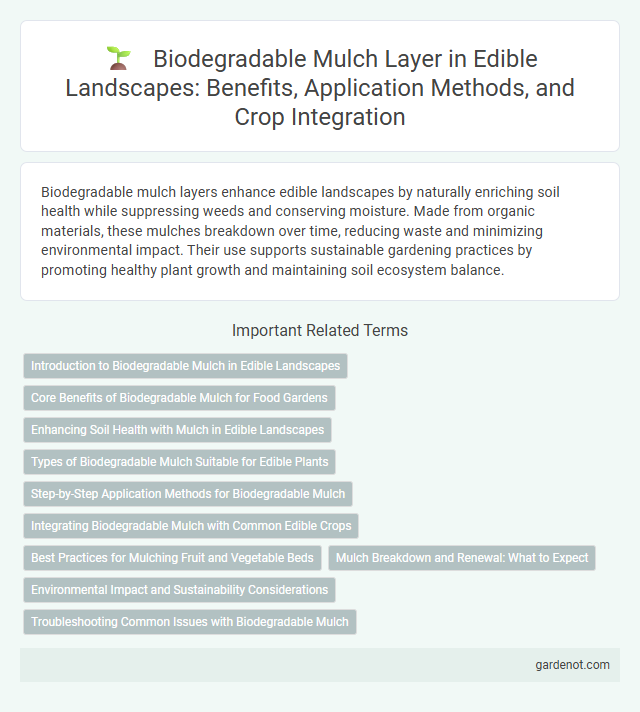Biodegradable mulch layers enhance edible landscapes by naturally enriching soil health while suppressing weeds and conserving moisture. Made from organic materials, these mulches breakdown over time, reducing waste and minimizing environmental impact. Their use supports sustainable gardening practices by promoting healthy plant growth and maintaining soil ecosystem balance.
Introduction to Biodegradable Mulch in Edible Landscapes
Biodegradable mulch layers in edible landscapes enhance soil moisture retention and temperature regulation while reducing weed growth, promoting healthier plant development. Made from natural materials like cellulose, starch, or biodegradable polymers, these mulches break down into non-toxic components that enrich the soil ecosystem. Their integration supports sustainable gardening practices by minimizing plastic waste and improving crop yield in fruit, vegetable, and herb gardens.
Core Benefits of Biodegradable Mulch for Food Gardens
Biodegradable mulch layers improve soil moisture retention and temperature regulation, promoting healthier root development in food gardens. They naturally decompose, reducing waste and eliminating the need for removal, which enhances sustainability. This mulch also suppresses weed growth, minimizing competition for nutrients and boosting crop yields.
Enhancing Soil Health with Mulch in Edible Landscapes
Biodegradable mulch layers improve soil health in edible landscapes by regulating moisture levels, suppressing weed growth, and gradually enriching the soil with organic matter as they decompose. These mulches, often made from materials like cornstarch or cellulose, support microbial activity and enhance nutrient availability essential for fruit and vegetable growth. Using biodegradable mulch preserves soil structure and promotes sustainable cultivation practices, leading to healthier, more productive edible gardens.
Types of Biodegradable Mulch Suitable for Edible Plants
Biodegradable mulch suitable for edible plants includes materials such as straw, coconut coir, and biodegradable films made from polylactic acid (PLA) or starch-based polymers. Straw mulch is effective for moisture retention and weed suppression while enriching the soil as it decomposes. Coconut coir offers excellent water retention and aeration, whereas PLA and starch-based films provide a plastic-like barrier that breaks down without harmful residues, promoting sustainable edible landscape practices.
Step-by-Step Application Methods for Biodegradable Mulch
Begin by thoroughly clearing the planting area of weeds and debris to ensure proper soil contact and mulch effectiveness. Lay the biodegradable mulch flat over the soil, securing the edges with stakes or soil to prevent wind displacement and maintain moisture retention. Make precise slits or holes in the mulch to transplant seedlings directly through, allowing for optimal growth while minimizing weed competition and conserving soil moisture.
Integrating Biodegradable Mulch with Common Edible Crops
Integrating biodegradable mulch with common edible crops such as tomatoes, peppers, and strawberries enhances soil moisture retention and suppresses weed growth, leading to healthier plant development and increased yield. This mulch layer breaks down naturally, enriching the soil with organic matter and reducing plastic waste associated with traditional mulches. Using biodegradable mulch aligns with sustainable gardening practices by promoting soil health and reducing environmental impact in edible landscapes.
Best Practices for Mulching Fruit and Vegetable Beds
Applying a biodegradable mulch layer in fruit and vegetable beds conserves soil moisture, suppresses weeds, and enriches soil health as it decomposes, promoting sustainable garden practices. Organic mulches such as straw, wood chips, and composted leaves are optimal, providing slow nutrient release while preventing soil erosion and temperature extremes. For best results, apply mulch in a 2-4 inch thick layer, ensuring it does not smother plant stems, allowing roots to breathe and maximizing crop yield and quality.
Mulch Breakdown and Renewal: What to Expect
Biodegradable mulch layers break down naturally through microbial activity, enhancing soil health by adding organic matter as they degrade. Expect the mulch to decompose fully within one to six months depending on environmental conditions such as temperature and moisture. Renewing the mulch layer periodically supports continuous weed suppression and moisture retention essential for thriving edible landscapes.
Environmental Impact and Sustainability Considerations
Biodegradable mulch layers significantly reduce plastic waste accumulation in edible landscapes by decomposing naturally into non-toxic components, enhancing soil health. These mulches improve moisture retention and suppress weeds without harmful chemical residues, fostering sustainable agricultural practices. Using biodegradable materials minimizes landfill contributions and lowers the carbon footprint compared to conventional plastic mulches, promoting long-term environmental stewardship.
Troubleshooting Common Issues with Biodegradable Mulch
Biodegradable mulch layers can encounter problems such as premature degradation, poor soil adhesion, and weed growth beneath the mulch. Ensuring proper installation, maintaining adequate soil moisture, and selecting high-quality mulch materials with appropriate degradation rates can mitigate these issues. Regular monitoring and adjusting environmental conditions help maximize the mulch's effectiveness in edible landscape applications.
Biodegradable mulch layer Infographic

 gardenot.com
gardenot.com